#oil and canvas
Explore tagged Tumblr posts
Text












Такая разная зима в работах современной русской художницы Веры Г. Волковой.
Волкова Вера Геннадьевна родилась в Санкт-Петербурге в 1980 г. В ее семье не было профессиональных художников, родители девочки не были связаны с изобразительным искусством. Отец всю свою жизнь работал в Водоканале, а мать трудилась на ткацкой фабрике - делала на ткацком станке нитки. Затем работала на заводе "Красная заря" , единственном в союзе производящем стационарные телефонные аппараты. Вера рисовала детские рисунки гуашью на бумаге с пяти лет. Потом родители с гордостью показывали их друзьям и коллегам. В течении трех лет - с первого и до окончания третьего класса средней школы ходила в детскую художественную школу им. Свиридова в СПб. Вера Волкова профессионально занимается живописью с 2000 года уже более 20 лет.
Such different winters in the works of the modern Russian artist Vera G. Volkova.
Vera Gennadyevna Volkova was born in St. Petersburg in 1980. There were no professional artists in her family, the girl's parents were not connected with the fine arts. Her father worked all his life in Vodokanal, and her mother worked in a weaving factory - she made threads on a loom. Then she worked at the Krasnaya Zarya plant, the only one in the union producing landline telephones. Vera drew children's pictures with gouache on paper from the age of five. Then her parents proudly showed them to friends and colleagues. For three years - from the first to the end of the third grade of secondary school, she went to the Sviridov Children's Art School in St. Petersburg. Vera Volkova has been professionally engaged in painting since 2000 for more than 20 years.
Источник:/www.artquid.com/seller/113822/artworks/recent, http://xn--80ak3adffht.xn--p1ai/modules.php?name=GalleryArt &do =showgall&gid=230, /artchive.ru/artists/67185 ~Vera_Gennad'evna _Volkova, /in.gallerix.ru/roksana.
#художник#Волкова Вера Геннадьевна#живопись#Реализм#пейзажист#картины#искусство#масло и холст#пейзаж#зима#горы и лес#река#закат#деревня#art#painting#artist#Vera Gennadyevna Volkova#landscape painter#Realism#oil and canvas#landscape painting#mountains and forest#river#winter#sunset#village
154 notes
·
View notes
Text

Norman Alfred William Lindsay (1879-1969) Australia.
Isabelle Y Orleans 1938. Óleo sobre lienzo, firmado y fechado "Norman Lindsay / 38" abajo en el centro, 100 x 74 cm.
La pintura "Isabelle and Orleans" de Norman Lindsay es una representación evocadora y sensual que destaca por su enfoque en la figura humana y el uso dramático de la luz y el color. La obra muestra a una mujer desnuda, Isabelle, acompañada de un hombre vestido con ropajes elaborados, probablemente Orleans.
Análisis Visual:
Composición y Posicionamiento:
Isabelle está en primer plano, posando con una actitud confiada y desafiante. Su mirada directa y su postura relajada capturan la atención del espectador. Orleans, detrás de ella, está vestido con una túnica rica en detalles y colores, lo que contrasta con la desnudez de Isabelle. Su expresión y postura sugieren una actitud de protección o posesión.
2. Color y Técnica:
Lindsay utiliza una paleta rica y vibrante, especialmente en la vestimenta de Orleans. Los tonos cálidos de la piel de Isabelle se destacan contra el fondo más oscuro y el ropaje de Orleans. La técnica pictórica es detallada y meticulosa, con un enfoque particular en las texturas, como se puede observar en los pliegues de la tela y los adornos del vestido.
3. Iluminación y Ambiente:
La iluminación está dirigida principalmente a Isabelle, resaltando su figura y creando un contraste entre la luz y la sombra que añade profundidad y dramatismo a la escena. El fondo oscuro y texturizado contribuye a enfocar la atención en los personajes principales, creando una atmósfera íntima y teatral.
Interpretación y Contexto:
Norman Lindsay, conocido por sus representaciones de la mitología y la sensualidad, probablemente busca explorar temas de poder, erotismo y la dinámica entre los sexos en esta obra. La desnudez de Isabelle puede interpretarse como una celebración de la forma femenina y su belleza natural, mientras que la vestimenta opulenta de Orleans puede simbolizar el poder y el estatus.
Conclusión:
"Isabelle and Orleans" es una obra que encapsula el estilo audaz y distintivo de Norman Lindsay. A través de la composición, el uso del color y la representación detallada de los personajes, Lindsay crea una pintura que es tanto provocativa como visualmente atractiva. La obra invita al espectador a reflexionar sobre las relaciones humanas, el poder y la sensualidad, características que definen gran parte del trabajo de Lindsay.
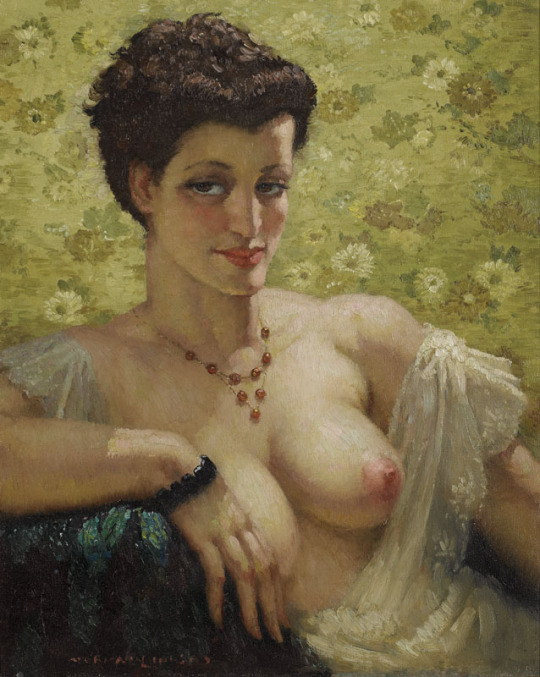
Norman Willian Lindsay. Rita 1945. Óleo sobre lienzo, firmado "Norman Lindsay" abajo a la izquierda, 54,2 x 44 cm
Isabelle And Orleans 1938. Oil on canvas, signed and dated "Norman Lindsay / 38" lower center, 100 x 74 cm.
Norman Lindsay's painting "Isabelle and Orleans" is an evocative and sensual depiction notable for its focus on the human figure and dramatic use of light and color. The work depicts a nude woman, Isabelle, accompanied by a man dressed in elaborate robes, probably Orleans.
Visual Analysis:
Composition and Positioning:
Isabelle is in the foreground, posing with a confident and defiant attitude. Her direct gaze and relaxed pose capture the viewer's attention. Orleans, behind her, is dressed in a richly detailed and colorful robe, which contrasts with Isabelle's nudity. His expression and posture suggest an attitude of protection or possession.
Color and Technique:
Lindsay uses a rich and vibrant palette, especially in Orleans' clothing. The warm tones of Isabelle's skin stand out against the darker background and Orleans' clothing. The painterly technique is detailed and meticulous, with a particular focus on textures, as can be seen in the folds of the fabric and the embellishments of the dress.
Lighting and Environment:
The lighting is primarily directed at Isabelle, highlighting her figure and creating a contrast between light and shadow that adds depth and drama to the scene. The dark, textured background helps to focus attention on the main characters, creating an intimate and theatrical atmosphere.
Interpretation and Context:
Norman Lindsay, known for his depictions of mythology and sensuality, likely seeks to explore themes of power, eroticism and the dynamics between the sexes in this play. Isabelle's nudity can be interpreted as a celebration of the female form and her natural beauty, while Orleans' opulent clothing may symbolize power and status.
Conclusion:
"Isabelle and Orleans" is a work that encapsulates Norman Lindsay's bold and distinctive style. Through composition, use of color, and detailed depiction of characters, Lindsay creates a painting that is both provocative and visually appealing. The work invites the viewer to reflect on human relationships, power and sensuality, characteristics that define much of Lindsay's work.
#art#pintura#arts#arte#Norman wiliian lindsay#Isabelle and Orleans#oil and canvas#oil#óleo#óleo sobre lienzo#rita
12 notes
·
View notes
Text

Art by The Unclean
#art#artist#artblr#goth#gothic#gothcore#macabre#dark academia#red academia#romantic academia#aesthetic#romance#painting#oil on canvas#oil painting#art gallery#artists#art community#art blog#witch#witches#witchblr#witchcraft#witchcore
45K notes
·
View notes
Text

By Roberto Ferri
#roberto ferri#paintings#painting#art#artist#artists#artblr#goth#dark academia#gothic#macabre#horror#fine art#aesthetic#oil on canvas#oil on linen#oil on panel#rural#midwest#regional gothic#rural america#rural decay#ruralcore#witch#witchcraft#witchblr#witches#witchcore
33K notes
·
View notes
Text

Not a brave man, but at times a very stubborn one
(Limited color palette assignment for my oil painting class. I love college <3)
#shoutout to the one person who painted jarchivist for their final project#i hope you have a wonderful day#manatee sketchbook#oil painting#oil on canvas#jarchivist#jonathan sims#tma#the magnus archives#magpod#the archivist
14K notes
·
View notes
Text

Ivan Pokidyshev Silence, 2023 Oil on canvas.
#ivan pokidyshev#art#contemporary art#light painting#light art#oil on canvas#contemporary painting#painting#oil painting#figurative art
25K notes
·
View notes
Text




















Cats Stealing Food in Paintings
Still Life with Cat (1705) by Desportes, It's no use crying over spilt milk (1880) by Frank Paton, Still Life of the Remnants of a Meal with a Lunging Cat (18th Century) by Alexandre-François Desportes, Fish Still Life with Two Cats (1781) by Martin Ferdinand Quadal, Still Life with a Cat and a Mackerel on a Table Top (18th Century) by Giovanni Rivalta, The Collared Thief (1860) by William James Webbe, Cat Stealing a String of Sausages (17th Century) by Abraham van Beyeren, Still Life with a Cat (1760) by Sebastiano Lazzari, Kitchen Still Life with Fish and Cat (ca. 1650) by Sebastian Stoskopff, An Oyster Supper (1882) by Horatio Henry Couldery, Still Life with an Ebony Chest (17th Century) by Frans Snyders, Still Life with a Cat (1724) by Alexandre-Francois Desportes, A Cat Attacking Dead Game (18th Century) by Alexandre-François Desportes, Still Life of Fresh-Water Fish with a Cat (1656) by Pieter Claesz, Still Life with Fruits and Ham with a Cat and a Parrot (18th Century) by Alexandre-Francois Desportes, A Cat Holding a Fish in Its Mouth (18th Century) by Sebastiano Lazzari, Still Life with a Cat and a Hare (18th Century) by Desportes, Still Life with Cat and Rayfish (1728) by Jean-Siméon Chardin, A Cat with Dead Game (1711) by Alexandre-Francois Desportes, Still Life with Cat and Fish (1728) by Jean Baptiste Siméon Chardin
Via James Lucas on X/Twitter
#cat#cats#art#artist#artblr#painting#oil on canvas#oil painting#artists#classical art#animals#pet#pets#cute#wholesome#funny#classic academia#historical painting#historical art#art history#renaissance art#renaissance#renaissance painting#paintings#fine art#art gallery#art community#art blog#kitten#kittens
39K notes
·
View notes
Text

L’ Amour de Pierrot, 1920 by Salvador Dalí
#art#surrealism#surreal#surealart#surealism#surealist#dark art#dark and moody#darkcore#dark illustration#gothcore#goth aesthetic#gothic#goth#dark fantasy#dark aesthetic#dark academia#skull#skull art#skulls#painting#oil painting#oil on canvas#oil paint#salvador dali#spanish#spain#x
17K notes
·
View notes
Text

Roberto Ferri, “Like Poison” (𝟤𝟢𝟤𝟥).
#roberto ferri#oil on canvas#painting#oil painting#dark aesthetic#dark art#art#artists on tumblr#dark romanticism
25K notes
·
View notes
Text

Vincent Giarrano, "Yuel", Oil on canvas
15K notes
·
View notes
Text


"Gazing into The World"-oil on canvas 100x60cm
ITWV is gonna begin filming and would you look at that, I finally finished editing this behemot, what a nice coincidence.
(If painting is hard, taking pictures and editing them is harder or i dread them more. I managed to make time to finish it because a kind person comissioned me for it.)
#louis de pointe du lac#lestat de lioncourt#claudia de pointe du lac#iwtv#my art#illustration#traditional art#artists on tumblr#oil painting#oil on canvas#interview with the vampire#loustat
4K notes
·
View notes
Text
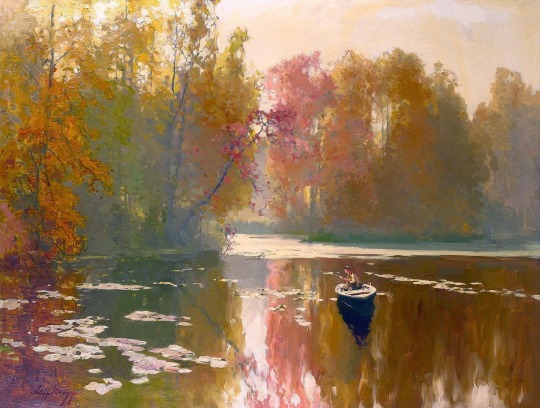

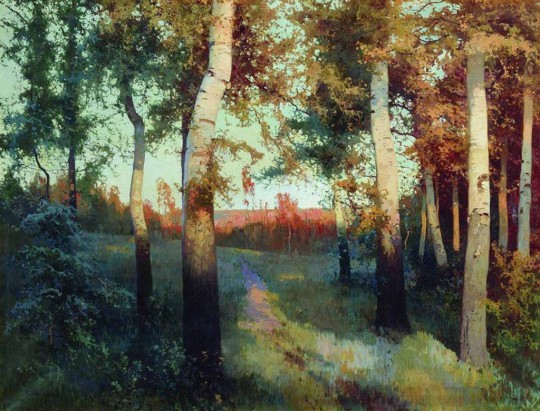



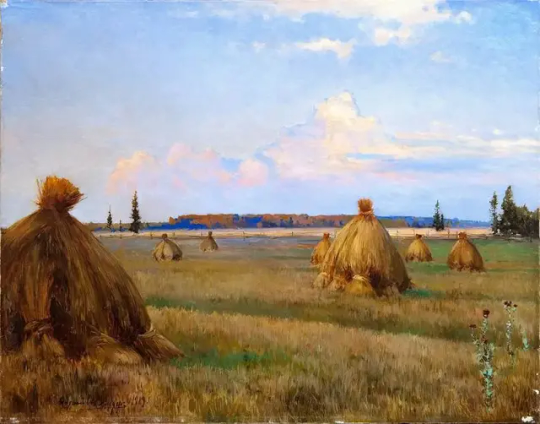

Осень в картинах русского художника-пейзажиста Шильдера Андрея Николаевича.
Андрей Иванович Шильдер (1861-1919) прославился как пейзажист, причем слава его вышла за пределы России. Он не получил специального образования, но занимался в мастерской у Ивана Ивановича Шишкина, влияние которого заметно в лесных пейзажах Шильдера. Но речь не идет о подражании. Ученик в духе века делает шаги от строгого реализма к игре со светом и тенью, к условности красок, но сохраняет при этом шишкинские традиции. В 1903 году Шильдера избирают академиком пейзажной живописи, но к тому времени он уже прославился, участвуя в крупнейших промышленных выставках: на Нижегородской Всероссийской выставке 1896 года он с большим успехом представляет панораму заводов Нобеля, названную «Город», а в 1900 году на Всемирной выставке в Париже Шильдер получает золотую медаль и диплом за панораму «Сбор каучука на Амазонке», написанную по заказу Российско-американской резиновой мануфактуры. Любопытно, что Шильдера приглашали даже на Олимпийские игры, и только наличие большого числа заказов удержало его от поездки на Олимпиаду. Шильдер много работал в иллюстрированных журналах: «Север», «Живописное обозрение», «Всемирная иллюстрация», «Ласточка», «Новь» и «Артист».
Работы Андрея Николаевича Шильдера представлены во многих областных художественных музеях и галереях: в Третьяковской галерее, Русском музее, Владимиро — Суздальском художественном музее — заповеднике, Ставропольской картинной галерее.
Autumn in the paintings of the Russian landscape artist Andrei Nikolaevich Shilder.
Andrei Ivanovich Shilder (1861-1919) became famous as a landscape painter, and his fame went beyond the borders of Russia. He did not receive a special education, but studied in the workshop of Ivan Ivanovich Shishkin, whose influence is noticeable in Shilder's forest landscapes. But we are not talking about imitation. The student, in the spirit of the century, takes steps from strict realism to play with light and shadow, to the conventionality of colors, but at the same time preserves Shishkin's traditions. In 1903, Schilder was elected an academician of landscape painting, but by that time he had already become famous by participating in major industrial exhibitions: at the Nizhny Novgorod All-Russian Exhibition of 1896, he presented a panorama of Nobel's factories, called "City", with great success, and in 1900, at the World Exhibition in Paris, Schilder received a gold medal and a diploma for the panorama "Rubber Harvesting on the Amazon", painted by order of the Russian-American Rubber Manufactory. It is curious that Schilder was even invited to the Olympic Games, and only the presence of a large number of orders kept him from going to the Olympics. Schilder worked a lot in illustrated magazines: "Sever", "Zhivopisnoye Obozreniye", "Vsemirnaya Illusion", "Lastochka", "Nov" and "Artist".
The works of Andrei Nikolaevich Schilder are presented in many regional art museums and galleries: the Tretyakov Gallery, the Russian Museum, the Vladimir-Suzdal Art Museum-Reserve, and the Stavropol Art Gallery.
Источник://eaculture.ru/picture/4203, //www.stydiai.ru /gallery/ shilder-andrey/, /artchive.ru/artists/28445 ~Andrej_ Nikolaevich _ Shil'der,/vsdn.ru/museum/catalogue/exhibit2310.htm.
#живопись#Реализм#пейзажист#художник#Андрей Иванович Шильдер#картины#искусство#масло и холст#пейзаж#осень#деревья#река#село#art#painting#artist#landscape painter#Andrei Ivanovich Shilder#Realism#oil and canvas#landscape painting#autumn#trees#river#village
149 notes
·
View notes
Text
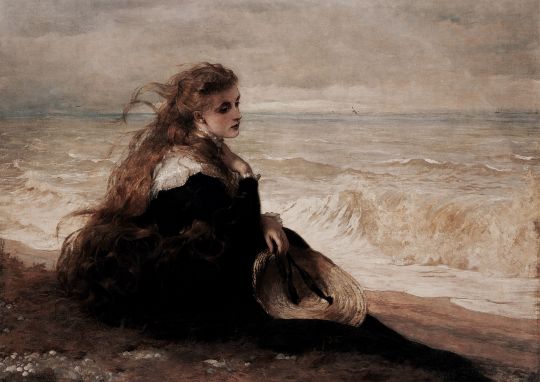
On the Seashore, George Elgar Hicks (1879)
#vintage#art#painting#old paintings#fine art#art history#history#vintage art#artist#artwork#1800s art#1800s#canvas#culture#old art#classical art#vintage aesthetic#artblr#naturecore#landscape#nature aesthetic#victorian#british art#oil painting#museum#history aesthetic#oil on canvas
20K notes
·
View notes
Text

the grumpy flower
-
oil on canvas
2024
#art#illustration#artoftheday#artists on tumblr#artist#love#cat#caturday#oil on canvas#oil painting#titsay#titsayart
5K notes
·
View notes
Text

Carl Kahler (1856-1906)
Three Black Cats
#art history#art appreciation#vintage#artwork#art#cats#kitty#art deco#lavish#dark aesthetic#dark academia#oil on canvas#oil painting
5K notes
·
View notes
Text


~ The One Alone ~
(Another oil painting I did for class! To match the Jarchivist one)
#this one's my final project#turned it in an hour ago wish me luck aaaaaaaaaaaaaaaa#oil on canvas#oil painting#the magnus archives#magpod#tma#martin blackwood#martin k blackwood#the lonely#manatee sketchbook#teaholding
7K notes
·
View notes